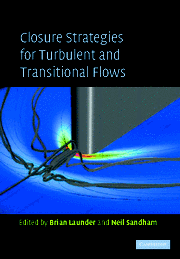Introduction
Published online by Cambridge University Press: 06 July 2010
Summary
Although Computational Fluid Dynamics (CFD) has developed to a point where it is a routine tool in many applications, several difficulties remain. Numerical issues, such as grid generation, are often difficult and costly, in the sense that much time and effort has to be devoted to the task, but they are manageable. The other main problem concerns the realistic physical modelling of turbulent and transitional flow, and is much less tractable.
The aim of this volume is to provide a reasonably comprehensive, up-todate and readable account of where the numerical computation of industrially important, single-phase turbulent flows has reached. Turbulent flow appears in such a diversity of guises that no single model used for engineering calculations can expect to mimic all the observed phenomena to the level of approximation sought. Thus, different levels and types of modelling are adopted according to the nature of the physical situation under study, the type of information to be extracted, and the accuracy required.
The book has been organized within three main sections. In Part A the focus is on techniques (with applications serving to illustrate the appropriateness of the technique adopted) while Part B examines particular types of flow, usually adopting a single preferred modelling strategy. Finally, in Part C, some current research approaches are introduced. Throughout, references to other articles in the book are given by their chapter number in square brackets. The individual articles themselves are sequenced broadly in terms of increasing complexity, at least within Parts A and B. The nomenclature undergoes some variation across the chapters, reflecting the differences habitually adopted in the journal literature over the different themes covered in the volume. Nomenclature for core variables is defined at the start of Chapter [1] and this is essentially common for Part A. Additional definitions or variants are provided in the individual chapters as needed.
Part A: Physical and Numerical Techniques
Chapters [1]–[6] present a sequence of articles on single point closure. These represent the core of what is usually understood by ‘turbulence modelling’. Chapter [1] by Gatski and Rumsey considers linear and non-linear models of eddy-viscosity type.
- Type
- Chapter
- Information
- Publisher: Cambridge University PressPrint publication year: 2002
- 2
- Cited by



